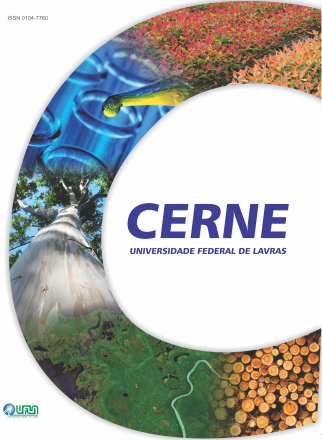VOLUME AND TAPER EQUATIONS FOR COMMERCIAL STEMS OF Nothofagus obliqua AND N. alpina
Cerne
VOLUME AND TAPER EQUATIONS FOR COMMERCIAL STEMS OF Nothofagus obliqua AND N. alpina
Autor Correspondente: Hernan Attis Beltran | [email protected]
Palavras-chave: Timber volume, Integration, Revolution solid, Decurrent
Resumos Cadastrados
Resumo Português:
O volume de madeira das árvores em pé é uma informação essencial para as decisões de gestão. A crescente necessidade de otimizar a capacidade potencial das florestas mantendo sua conservação, requer a quantificação dos diferentes possíveis produtos de madeira possíveis. O objetivo era ajustar equações de afilamento para determinar volumes de diferentes produtos de madeira para hastes comerciais de Nothofagus alpina e N. obliqua. As árvores de ambas as espécies foram selecionadas ao acaso nas áreas de colheita do Parque Nacional Lanin (Argentina). As árvores foram derrubadas e cortadas em troncos comerciais, medindo o diâmetro com a casca em diferentes alturas até o início da coroa, e para cada árvore o diâmetro na altura do peito e altura total. Foram selecionadas cinco equações cônicas e foram empregados processos de regressão não-linear para ajustar. Obtivemos o volume através da integração da equação do perfil do caule e da rotação no seu espaço através do sólido da revolução. O modelo de Bennet e Swindel (1972) foi selecionado para as duas espécies de Nothofagus, obtendo parâmetros de equação semelhantes e observando-se diferenças no topo das hastes de árvores maiores. Portanto, o uso de um modelo integrado não é recomendado. Com as equações obtidas é possível: (i) estimar o volume em diferentes alturas e para diferentes diâmetros comerciais, e (ii) prever a altura em que ambas as espécies atingem um determinado diâmetro. O modelo apresentou algumas limitações estatísticas (por exemplo, multicolinearidade), no entanto, o ajuste da equação e a compreensão fácil das saídas o suportam como uma ferramenta útil em uma ampla gama de aplicações florestais.
Resumo Inglês:
Timber volume of standing trees is essential information for management decisions. The increasing need to optimize the potential capacity of forests maintaining their conservation, requires the quantification of the different potential possible timber products. The aim was to adjust taper equations to determine volumes of different timber products for commercial stems of Nothofagus alpina and N. obliqua. Trees of both species were randomly selected in harvesting areas of Lanin National Park (Argentina). Trees were felled and cut into commercial logs, measuring diameter with bark at different heights up to the beginning of the crown, and for each tree the diameter at breast height and total height. Five taper equations were selected and non-linear regression processes were employed for the fittings. We obtained the volume through the integration of the stem profile equation and the rotation in the space thereof through solid of revolution. The Bennet and Swindel (1972) model was selected for both Nothofagus species, obtaining similar equation parameters and differences were observed at the top of the stems of larger trees. For this the use of an integrated model is not recommended. With the obtained equations it is possible to: (i) estimate volume at different heights and for different commercial diameters, and (ii) predict the height at which both species reach to a certain diameter. The model presented some statistical limitations (e.g. multicollinearity), however, the fitting of the equation and the easy understanding of the outputs support it as a useful tool in a broad range of forest applications.

